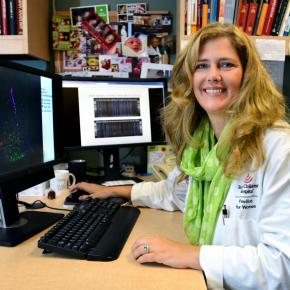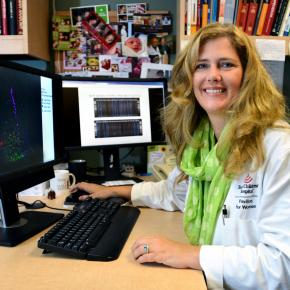
Credit: Baylor College of Medicine
A novel marmoset model of human Zika virus infection offers new opportunities for better understanding of how the virus causes congenital disease in humans. The researchers found that infection of marmoset dams recapitulates the human infection more faithfully than infections in other animal models, providing opportunities to study disease repercussions in ways that were not previously available. The study appears in the journal Scientific Reports.
"We were interested in using primate models to better understand how the Zika virus spreads from the mom to the fetus," said first author Dr. Maxim Seferovic, a postdoctoral associate in obstetrics and gynecology at Baylor College of Medicine. "We found that the available models, including several mouse models as well as rhesus, pigtail and macaque models, were not accurately replicating what we see in humans and had several limitations."
The researchers decided to work with the common marmoset, a non-human primate, because their work had previously shown that the marmoset offered several advantages over other animal models. For instance, other human viral infections, such as those caused by Lassa virus, Ebola/Marbug virus and dengue and West Nile virus, can be reproduced in the common marmoset. Also, the researchers had shown before that Zika virus infection in male common marmosets resembles many aspects of the infection seen in humans. When combined with the research team's previous work showing the importance of relatively longer periods of placental growth in successful marmoset pregnancies, these small New World monkeys were ideal models to study congenital Zika syndrome.
"We had previously demonstrated that Zika virus replicates in placental cells isolated from normal human term pregnancies, enabling the placenta to serve as a reservoir for the virus and an eventual portal to the developing fetus. When combined with our initial infection data in male marmosets, we were encouraged to determine whether infection of marmoset dams would more faithfully recapitulate maternal infection observed in humans when compared to mouse models," said corresponding author Dr. Kjersti Aagaard, professor of obstetrics and gynecology at Baylor and Texas Children's Hospital.
A novel animal model for Zika virus congenital syndrome
"We found that the common marmoset does faithfully recapitulate the human disease, including spontaneous demise and pregnancy loss, which is accompanied by infection and destruction in the brain of the fetus. We also learned something new — that the marmoset presented with an unexpectedly high rate of pregnancy loss. This will now prompt us to look back carefully for additional evidence of pregnancy loss and miscarriage in infected human patient populations," said Aagard, who also is professor of molecular and human genetics, molecular and cell biology and molecular physiology and biophysics.
Interestingly, the researchers also observed that the virus replicates the most in the marmoset placenta; however, they saw no evidence of robust inflammation in the placenta itself. On the other hand, they did see evidence that the dam can recognize and fight the virus; they determined the presence of antibodies against the virus and an inflammatory response in the dam's blood. These results support previous observations by Aagaard's team and others studying Zika infection in human pregnancies, but more studies are needed to explain the lack of immune response in the marmoset placenta.
"Importantly, this study provides a novel model that faithfully recapitulates human congenital Zika syndrome," said Aagaard, who also is a maternal-fetal medicine specialist working with high-risk pregnancies at Ben Taub and Texas Children's Hospital. "We anticipate that the marmoset model will likely provide new insights into Zika congenital infections that would potentially lead to effective preventive and therapeutic strategies in the future."
###
Other contributors to this study include Claudia Sánchez¬San Martín, Suzette D. Tardif, Julienne Rutherford, Eumenia C.C. Castro, Tony Li, Vida L. Hodara, Laura M. Parodi, Luis Giavedoni, Donna Layne-Colon, Manasi Tamhankar, Shigeo Yagi, Calla Martyn, Kevin Reyes, Melissa Suter, Charles Y. Chiu and Jean L. Patterson. The authors are affiliated with one or more of the following institutions: Baylor College of Medicine, Texas Children's Hospital, University of California at San Francisco, Texas Biomedical Research Institute at San Antonio, University of Illinois at Chicago and California Department of Public Health.
This study was supported in part by the National Institutes of Health grants R01-HL105704, R21-AI129455, R24-DK090964, R01-HD091731 and R01 DK089201. The animal work in this study was supported by the Southwest National Primate Research Center (P51-OD11133) and Texas Biomedical Research Institute.
Media Contact
Jeannette Sanchez
[email protected]
713-798-4710
@bcmhouston
https://www.bcm.edu/news
Original Source
https://www.bcm.edu/news http://dx.doi.org/10.1038/s41598-018-25205-1




